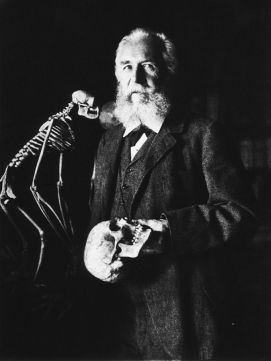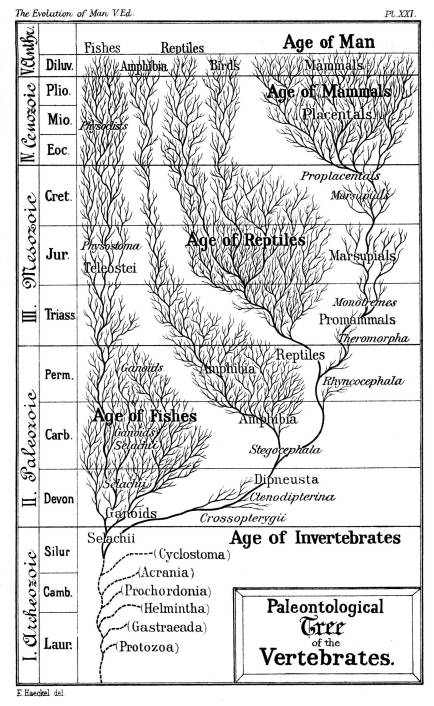 Ernst Haeckel (1834 – 1919) was what we call a renaissance man. He was a professor, biologist, philosopher, physician, naturalist and artist. His contribution to biology, evolutionary theory and art is still mind-boggling; we owe a great deal of biological understanding and terminology to him. He was a great promoter of Darwin’s theory of evolution, and created amazing visualisations by intense use of microscope. Maybe his greatest talent was the art of seeing. To actually observe and recreate what he saw into art. And science.
Ernst Haeckel (1834 – 1919) was what we call a renaissance man. He was a professor, biologist, philosopher, physician, naturalist and artist. His contribution to biology, evolutionary theory and art is still mind-boggling; we owe a great deal of biological understanding and terminology to him. He was a great promoter of Darwin’s theory of evolution, and created amazing visualisations by intense use of microscope. Maybe his greatest talent was the art of seeing. To actually observe and recreate what he saw into art. And science.
And look at him: how can you not love the guy in that portrait?

Some of his plates have since been found to be inaccurate, but in my book that I can forgive him. The value of his work, his art and the importance of combining art and science cannot be underestimated. I am not going to get into a massive biography or description of his scientific work; go forth and research yourself. I will simply show some of his stunning observations.
Using the ever better technology of the microscope, he stared at sea creatures and reproduced what he saw in painstaking detail. His artistic ambition, was to show the world the amazing shapes in nature, shapes that was not accessible to the general public. His scientific ambition was to use the insight to elaborate on his theories of the shape-shifting of natural selection. Spanning art and science. The place I want to live.
He published a lot of his art in a series called Kunstformen der Natur (Art Forms of Nature) that are still – to me at least – a source of inspiration and wonder. They are both abstract and accurate; both fiction and science. It does not get better than that.
 He also made several trees of life; visualisation of the idea of evolution. There are a lot of efforts to do this; we still struggle with it today, but this is one of my favourites. Though some knowledge has been added, some geological time has been shuffled, renamed and changed, it is still impressive in its noise-to-signal ratio. What is easily seen, and abundantly clear looking at this, is how the various groups waxes and wanes, diminish and expands. You can see the extinction of dinosaurs, how they transformed into birds, how few reptiles we have left, and how mammals took over most niches. It is well worth a study.
He also made several trees of life; visualisation of the idea of evolution. There are a lot of efforts to do this; we still struggle with it today, but this is one of my favourites. Though some knowledge has been added, some geological time has been shuffled, renamed and changed, it is still impressive in its noise-to-signal ratio. What is easily seen, and abundantly clear looking at this, is how the various groups waxes and wanes, diminish and expands. You can see the extinction of dinosaurs, how they transformed into birds, how few reptiles we have left, and how mammals took over most niches. It is well worth a study.
So without further ado; here are some of his amazing art. And science:

Arachnid (Arachnida)

Nudibranch (Nudibranchia)

Hummingbird (Trochilidae)

Siphonophorae

Moss (Muscinae)

Cephalopod (Gamochonia)

Anthomedusa (Anthomedusae)

Boxfish (Ostraciontes)

Discomedusae.


 Ernst Haeckel (1834 – 1919) was what we call a renaissance man. He was a professor, biologist, philosopher, physician, naturalist and artist. His contribution to biology, evolutionary theory and art is still mind-boggling; we owe a great deal of biological understanding and terminology to him. He was a great promoter of Darwin’s theory of evolution, and created amazing visualisations by intense use of microscope. Maybe his greatest talent was the art of seeing. To actually observe and recreate what he saw into art. And science.
Ernst Haeckel (1834 – 1919) was what we call a renaissance man. He was a professor, biologist, philosopher, physician, naturalist and artist. His contribution to biology, evolutionary theory and art is still mind-boggling; we owe a great deal of biological understanding and terminology to him. He was a great promoter of Darwin’s theory of evolution, and created amazing visualisations by intense use of microscope. Maybe his greatest talent was the art of seeing. To actually observe and recreate what he saw into art. And science.
 He also made several trees of life; visualisation of the idea of evolution. There are a lot of efforts to do this; we still struggle with it today, but this is one of my favourites. Though some knowledge has been added, some geological time has been shuffled, renamed and changed, it is still impressive in its noise-to-signal ratio. What is easily seen, and abundantly clear looking at this, is how the various groups waxes and wanes, diminish and expands. You can see the extinction of dinosaurs, how they transformed into birds, how few reptiles we have left, and how mammals took over most niches. It is well worth a study.
He also made several trees of life; visualisation of the idea of evolution. There are a lot of efforts to do this; we still struggle with it today, but this is one of my favourites. Though some knowledge has been added, some geological time has been shuffled, renamed and changed, it is still impressive in its noise-to-signal ratio. What is easily seen, and abundantly clear looking at this, is how the various groups waxes and wanes, diminish and expands. You can see the extinction of dinosaurs, how they transformed into birds, how few reptiles we have left, and how mammals took over most niches. It is well worth a study.







